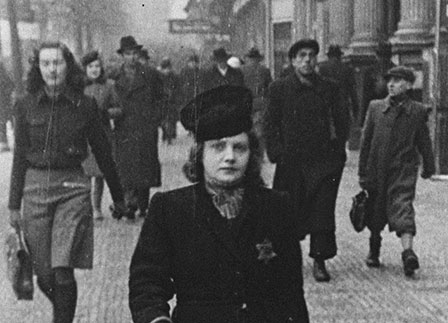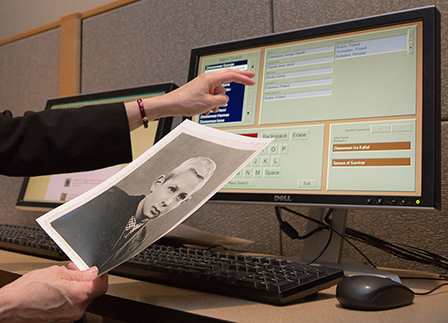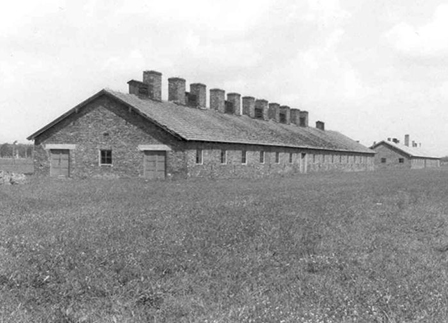Overview
- Brief Narrative
- I saw the Reichstag fire. And they beheaded the poor simple Dutch boy Marinus van der Lubbe for this crime they committed a few days before Hitler came to power in 1933!
- Artwork Title
- Reichstagbrand - dem Deutschen Volke
- Subtitle
- The Nazis as Arsonists
- Series Title
- 12 in a series of 31
- Date
-
publication/distribution:
1940 October 23
- Credit Line
- United States Holocaust Memorial Museum Collection
- Signature
- lower left hand corner, in pencil, "Wm. Sharp"
- Contributor
-
Artist:
William Sharp
- Biography
-
Leon Schleifer was born in 1900 in Germany. He served in the German army at the end of World War I (1914-1918). He became a political cartoonist and his work was published in the anti-Nazi press. He also specialized in courtroom trial sketches. After the appointment of Hitler as Chancellor in 1933, Schliefer emigrated to the United States. He changed his name to William Sharp and continued his career as an editorial cartoonist and illustrator. His work was published in the New York Times, Life Magazine, and other publications. He died in 1961, age sixty-one years.
Physical Details
- Language
- German
- Classification
-
Art
- Category
-
Drawings
- Object Type
-
Drawing (lcsh)
- Physical Description
- Image of huge gothic building on fire; "Reichstagbrand-dem Deutschen Volke" written on building; four Nazi soldiers duck in foreground, the rear one holding a lit torch.
- Dimensions
- overall: Height: 19.610 inches (49.809 cm) | Width: 11.140 inches (28.296 cm)
- Materials
- overall : paper, charcoal, ink, graphite
- Inscription
- lower left corner, in pencil, "27"
Rights & Restrictions
- Conditions on Access
- No restrictions on access
- Conditions on Use
- Restrictions on use
Keywords & Subjects
Administrative Notes
- Legal Status
- Permanent Collection
- Provenance
- The drawing was aquired by the United States Holocaust Memorial Museum in 1991.
- Record last modified:
- 2023-07-06 13:23:31
- This page:
- http://collections.ushmm.org/search/catalog/irn4739
Download & Licensing
In-Person Research
- By Appointment
- Request 21 Days in Advance of Visit
- Plan a Research Visit
- Request to See This Object
Contact Us
Also in William Sharp collection
The collection consists of a series of thirty-one drawings created by William Sharp, a political cartoonist who left Nazi Germany for the United States in 1933, in the early 1930s and published in PM newspaper in October 1941. Associated with PM (New York, N.Y.) newspaper, printed between 1940 and 1948.
Date: 1933-1935
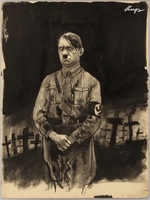
Anti-Nazi drawing published in the PM newspaper
Object
This is probably the most revealing, most pitiless picture of Adolf Hitler ever drawn. William Sharp sketched it in Germany in 1934, long before the world realized how much blood would be shed by Der Fuehrer. Sharp's caption for the picture says: "I saw this man three times in 1931 when he testified at the trial of three of his brutal Storm Troopers for killing an enemy of the Nazis. His eyes looked just like this."
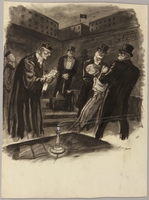
Anti-Nazi drawing published in the PM newspaper
Object
These are the sketches and drawings with which I got out of Germany in 1934. They were done from scenes I witnessed myself, and from accounts by reliable witnesses. They show things that were going on in Germany while Hitler was sending his Storm Troopers, "the conquerors of the streets," beating and stomping and shooting men to death, and after he came to power, some of the pictures I brought out in sketch form, afraid to finish them. A newspaper man saw the scene above in 1933, and told me about it. The dress clothes cannot hide the brutality of the headsman and his assistants, who are about to execute a man whose crime was that he objected to tyranny. Se [sic] the sanctimonius pastor at the left! Not all of them were like Pastor Niemoller, who dared to denounce the crime of the Nazis. The prosecutor is reading the death warrant "in the name of the people." What a ghastly joke!
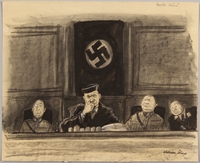
Anti-Nazi drawing published in the PM newspaper
Object
Can you imagine getting justice at the hands of these men? That one at the ledt is a member of the army. Next is the judge, then a Storm Troop officer, and of course, the one at the right is a member of the Gestapo. And they call this a People's Court! I attended many trials presided over by men with faces like this. I did not see any justice dispensed. I sketched this in Germany and finished it in the U.S.A.
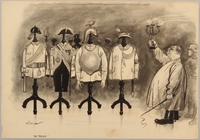
Anti-Nazi drawing published in the PM newspaper
Object
No matter how funny you found fat Hermann Goering and his uniforms, you didn't laugh out loud, anyhow. I completed this sketch in Germany in 1933 - a risky thing to do with the Nazis in the saddle and Goering president of the Reichstag. That whip in his hand isn't just for show: Goering is one of the cruelest men in Germany. It was he who decreed that the medieval axe should be used for death sentence. He was a big help to Hitler.
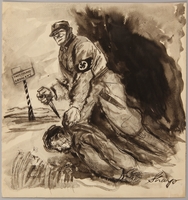
Anti-Nazi drawing published in the PM newspaper
Object
This one I did in America in 1935, with bitterness and a heavy heart. This man was my friend. He was Berthold Jacob, a Berlin newspaper man who hated Hitlerism, and said and wrote so. He was kidnapped from his hotel in Basel, Switzerland, beaten and dragged across the border. He testified at the kidnapper's trial in Switzerland. For a while Jacob was in a prison camp. What happened to him after that, I don't know.
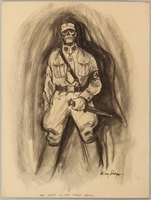
Anti-Nazi drawing published in the PM newspaper
Object
To me the spirit of the Third Reich is death in a Brown Shirt. I hated and feared the Nazis from the time they began to be powerful. When such things could be printed, I contributed drawings under an assumed name to the newspapers hostile to Hitler. That was to make trouble for me later.
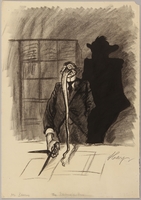
Anti-Nazi drawing published in the PM newspaper
Object
I completed this sketch in Germany. The censor sniffs and sniffs. His ears and scissors miss nothing. You remember Luther threw an inkpot at the devil's head. Since then, the devil has been afraid of ink.
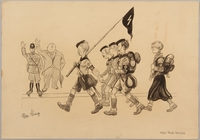
Anti-Nazi drawing published in the PM newspaper
Object
This is the most terrible thing about Germany - the way the children are growing up. These innocents were singing: "You storm troopers young and old, take your weapons in your hand, for the Jews have launched confusion in the German Fatherland." The men on the curb have a right to be complacent. They know that the little boys will carry bombs and guns in a few years.
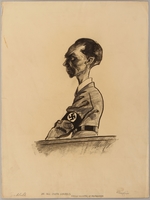
Anti-Nazi drawing published in the PM newspaper
Object
Dr. Paul Goebbels is one of the most vindictive men I know of. He threatened me with concentration camp for anti-Nazi drawings I did under an assumed name.
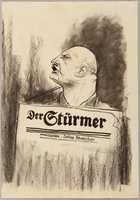
Anti-Nazi drawing published in the PM newspaper
Object
This man is a newspaper publisher and what a newspaper DER STUERMER is! Obscene, ranting, Streicher, one of Hitler's earliest supporters, is Nazi commissioner for Franconia, and is violently antisemitic.
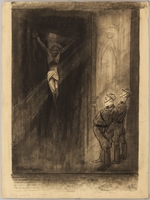
Anti-Nazi drawing published in the PM newspaper
Object
In 1934, something some Nazi had written. This was it: "How high Horst Wessel towers over that Jesus of Nazereth." Horst Wessel was a rough neck, a panderer, one of Hitler's hooligans. He was killed in a street brawl, and he is a Nazi hero. This is the way the Nazis really feel about the Church. They once tried to prove that Jesus was a Nordic.
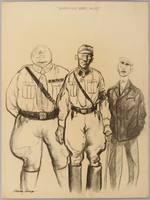
Anti-Nazi drawing published in the PM newspaper
Object
These are some of Nietzche's supermen, sketched from life. The man at the left is a labor leader. In the center, the real superman, the storm trooper. A Heidelberg student at the right.
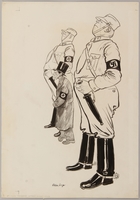
Anti-Nazi drawing published in the PM newspaper
Object
The man in the center is the minister of enlightenment, the Herr Doctor Joseph Goebbels. He takes no chances when he goes among the people he enlightens. I call him "Wotan's Mickey Mouse."
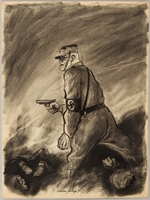
Anti-Nazi drawing published in the PM newspaper
Object
Dietrich Eckart was one of Hitler's earliest admirers. He died in 1923, but he left a testament. It is the poem, "GERMANY AWAKE!" full of inflammatory stuff. Well, this picture shows how Germany has awakened: a blood-thirsty maniac with a smoking pistol, plowing through heaps of dead. I completed this drawing in 1934, about the time of the Blood Purge.
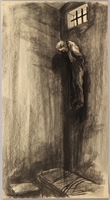
Anti-Nazi drawing published in the PM newspaper
Object
This was Dr. Erich Mucsahm. He was arrested the night of the Reichstag fire, beaten so badly he became deaf, thrown into a concentration camp. They hanged him in his cell, called it a suicide.
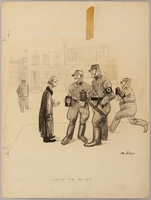
Anti-Nazi drawing published in the PM newspaper
Object
These pleasant looking fellows are telling the poor old mendicant that if there is any begging to be done, they'll be do it-for the pockets of the party faithful.
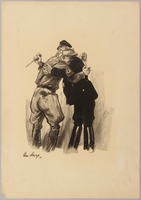
Anti-Nazi drawing published in the PM newspaper
Object
This is the way it was between Heinrich Himmler's Schutzstaffel and Capt. Ernst Roehm's Sturmabteilung. Himler still goes on. Roem died in the Blood Purge in 1934. On the figure wearing the Nazi uniform, the swastika is not visible. The viewer can only see his right arm, the swastika is usually on the left arm.
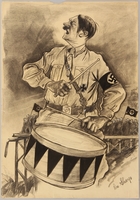
Anti-Nazi drawing published in the PM newspaper
Object
Once when Adolf Hitler was standing by the tomb of Richard Wagner, whose music he adores, he referred to himself as "the young drummer of the German people." He has been a drummer all right [sic], thumping the tom-toms of hate and "race" to a chorus of hysterical "Heils" while the German people march blindly to their destruction. This drawing I completed in Germany. Imagine what would have happened if the Gestapo had seen it.
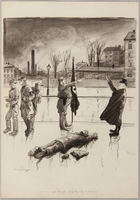
Anti-Nazi drawing published in the PM newspaper
Object
This happened in 1934 Wedding, a Berlin suburb where lots of working class live, and a friend of mine saw the whole affair. The underfed laborer had allowed the swastika banner to go by without saluting it. He was shot dead by one of the "conquerors of the streets" as the Storm Troopers were called. And the policeman at the right exchanges formalities with the murderer. There was a lot of this sort of thing that year.
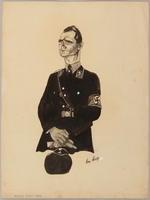
Anti-Nazi drawing published in the PM newspaper
Object
Rudolf Hess is Hitler's most devoted servant.
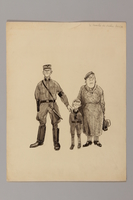
Anti-Nazi drawing published in the PM newspaper
Object
The German family. A very ordinary burgher on weekdays, he is transformed when he puts on the uniform on Sunday. She belongs to a woman's group.
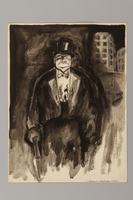
Anti-Nazi drawing published in the PM newspaper
Object
This man used to be a horse butcher, a knacker, of Magdeburg. Just an ordinary butcher. When the Nazis came in, he became a headsman, he operated a laundry. Oh, yes, the German people ate the flesh of the horses he slaughtered.
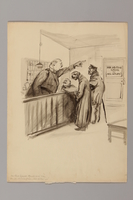
Anti-Nazi drawing published in the PM newspaper
Object
They came to the police station for help. They are being bawled out for not saluting the officer with "Heil Hitler." The sign says that is the proper German greeting, but they couldn't read. They were blind.
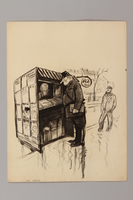
Anti-Nazi drawing published in the PM newspaper
Object
This happened on my street in 1933. The policeman is looking for foreign newspapers that might be critical of Hitlerism. He carries a book of regulations. His long nose makes a good censor.
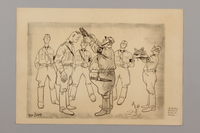
Anti-Nazi drawing published in the PM newspaper
Object
Four Storm Troop bullies in 1932 haouled an enemy of the Nazis out of his house in Beuthen, Silesia, and stomped him to death. They were sentenced to death and while they were awaiting execution, Hitler sent them congratulations. When he became Chancellor, they were pardoned. One or two of them got very good jobs in the Nazi party. In that year, political murders jumped from eight a month to 19 a month in June, went to 86 a month in July.
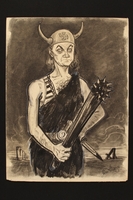
Anti-Nazi drawing published in the PM newspaper
Object
That is Alfred Rosenberg, the intellectual of the Nazi pafty [sic], most ardent of the paganists. The Nazis couldn't reconcile Christianity and Hitlerism so here is Rosenberg as a Wotan in a wold skin and a striped undershirt. The gibbets stand, the cross is broken.
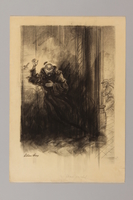
Anti-Nazi drawing published in the PM newspaper
Object
To the Nazis, any division of loyalty is unthinkable. So the Church is the sufferer, the State commands all devotion. Persecution of clergy is relentless. Nazis call priests "black moles."
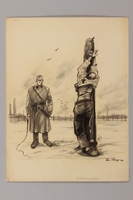
Anti-Nazi drawing published in the PM newspaper
Object
This happened in 1934 in Oranienburg, where there is a big concentration camp. This was a political prisoner, in "protective custody." Nearly 50,000 persons were sent to those places in that year.
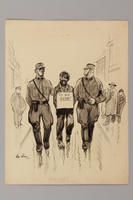
Anti-Nazi drawing published in the PM newspaper
Object
I saw this in Berlin in 1934. The next stop was the concentration camp, but even that was welcome after the shame of the streets. This happened more often in small towns.
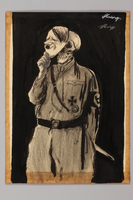
Anti-Nazi drawing published in the PM newspaper
Object
Perhaps sometime, the German people will see the fleshless bones behind the mask that the Fuehrer wears. He has fooled them so far. It cannot last forever. This is the closing picture in my sketchbook. I hope the lesson is well read.

